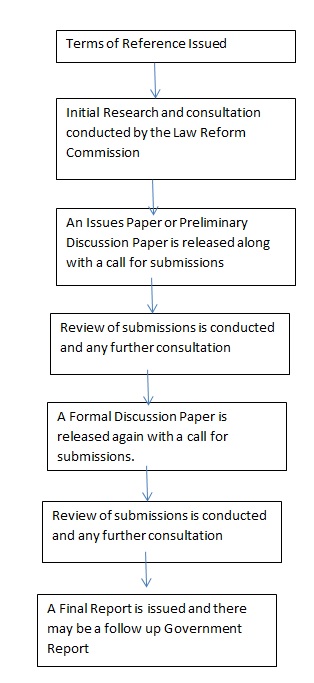Law Reform in Australia
"Law reform is the modernisation of the law by: bringing it into accord with current
conditions; the elimination of defects in the law; the simplification of the law;
and the adoption of new or more effective methods for the administration of the law
and the dispensation of justice" (Encyclopaedic Australian Legal Dictionary).
Through the inquiry process, law reform agencies produce:
- issues papers
- background papers
- draft recommendation papers and
- reports.
The process for each law reform project may differ according to the scope of inquiry, the range of key stakeholders, the complexity of the laws under review, and the period of time allotted for the inquiry. There is an Australian Law Reform Commission as well as Law Reform Commissions based in each State.
The Formal Law Reform Process generally looks as follows:

Terms of Reference
The Terms of Reference set out the subject matter of an inquiry and define its goals.
Consultations
The Law Reform Commission conducts research and consultations with stakeholders. Inquiry stakeholders may include: government departments, courts, legal professionals, industry groups, non government organisations, special interest groups, academics and other members of the community. Essentially, the ALRC seeks to consult with people who have expertise and experience in the laws under review, as well as people likely to be affected by the laws in question.
Issues Papers
An Issues Paper is usually the first official publication of an inquiry. It provides a preliminary look at issues surrounding the inquiry and often suggests or outlines principles which could guide proposals for reform. It serves to educate the community about the range of issues under consideration, and invites feedback in the form of submissions.
Submissions
The ALRC makes a formal call for submissions whenever it releases an Issues Paper or Discussion Paper. Through the submissions it receives, the ALRC can gauge what people think about current laws, how they should be changed and can test its proposals for reform with stakeholders prior to finalising them. Submissions can contain comments on matters raised in an Issues or Discussion Paper, or might discuss anything relevant to the topic under review. Anyone is welcome to make a submission.
Discussion Papers
Discussion Papers are typically much more detailed documents than Issues Papers. They provide a detailed account of research to that point, including a summary of the various consultations and submissions undertaken and received, and set out draft proposals for reform. Following the release of a Discussion Paper the Law Reform Commission will call for further submissions and undertake additional consultation.
Final Reports
Each inquiry culminates in a Final Report, which must be delivered to the Attorney-General by the date specified in the Terms of Reference. The Final Report makes specific recommendations for changes to the law or legal processes. It also describes in detail the Law Reform Commission's research and explains how the Law Reform Commission has arrived at its recommendations for reform.
With many thanks to the Australian Law Reform Commission Website for this information.
